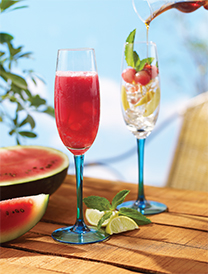There are many different textures and colours involved when it comes to food. How do you balance all that?
That’s a great question. Food photography is not simply about picking up a camera and clicking a beautiful looking plate of food! You need to understand the language of photography and use it to convey a thought, idea or a mood, not simply document the food. Keep in mind that every element included in the frame is contributing to the image in a subtle way. Of course the food is usually the most important part of the image and is the main focus of what we’re really trying to sell, but without all the other supporting elements to emphasize it, the food on it’s own would look dull and uninteresting When you’re creating a food photograph, you have to consider all aspects of the image, such as the light, the composition, the food, flatware, props, backgrounds and colours. Use a play of light to create textures and mood. Create a composition which gives a sense of movement and directs the viewer’s eye to the point of interest. And finally choose props and colours which complement the food, the light, and the composition, as well as give a sense of place and time. The viewer cannot get that from the food alone.

What are some of the most challenging aspects of this genre of photography?
A dish sitting in front of you at home or in a restaurant looks yummy. But place it in front of the camera, and it develops a mind of its own! Sauces will drip in the most unappetising way, ice-cream will melt to sludge before you can focus on a scoop, a simple sandwich won’t sit straight, and just as you’ve set your light, that piece of cottage cheese will turn its face the other way.
A food stylist’s tricks and techniques for dealing with these challenges are now well documented and easily accessible to anyone who is interested. But I think very few people actually mention the pain-staking effort involved in the process and the infinite amount of patience required to create the perfect image when dealing with this genre!
Another somewhat challenging aspect (and this applies to most genres of photography) is perhaps keeping yourself aware of the rapidly changing trends and technology. I’ve always been interested in updating myself on food, art and technology. I’m a also big equipment-geek, so for me, this is one of the most fun aspects of what I do.
What would you advise people who are interested in this field?
For anyone particularly interested in becoming ba professional food photographer, I would honestly say that I don’t think it’s a great idea to limit yourself to one particular genre of photography at the start of your career. As I mentioned earlier, photography is a language, and the more one converses in it, the more fluent one becomes. If you’re going to focus on just one aspect of that language, you’re definitely going to miss out on developing your ability to use photography as an effective medium of communication and expression.
Having said that, as a food photographer, you should find inspiration in everything you experience, like art, nature and music. Don’t just restrict yourself to observing the work of other food photographers. There is an overwhelming amount of images around us these days, and you need to be able create an image which stands apart from the crowd effortlessly, without looking forced. You need to photograph and edit your work tirelessly. That’s the first step to developing and understanding your personal original vision. That is the only way to carve a niche for yourself.

